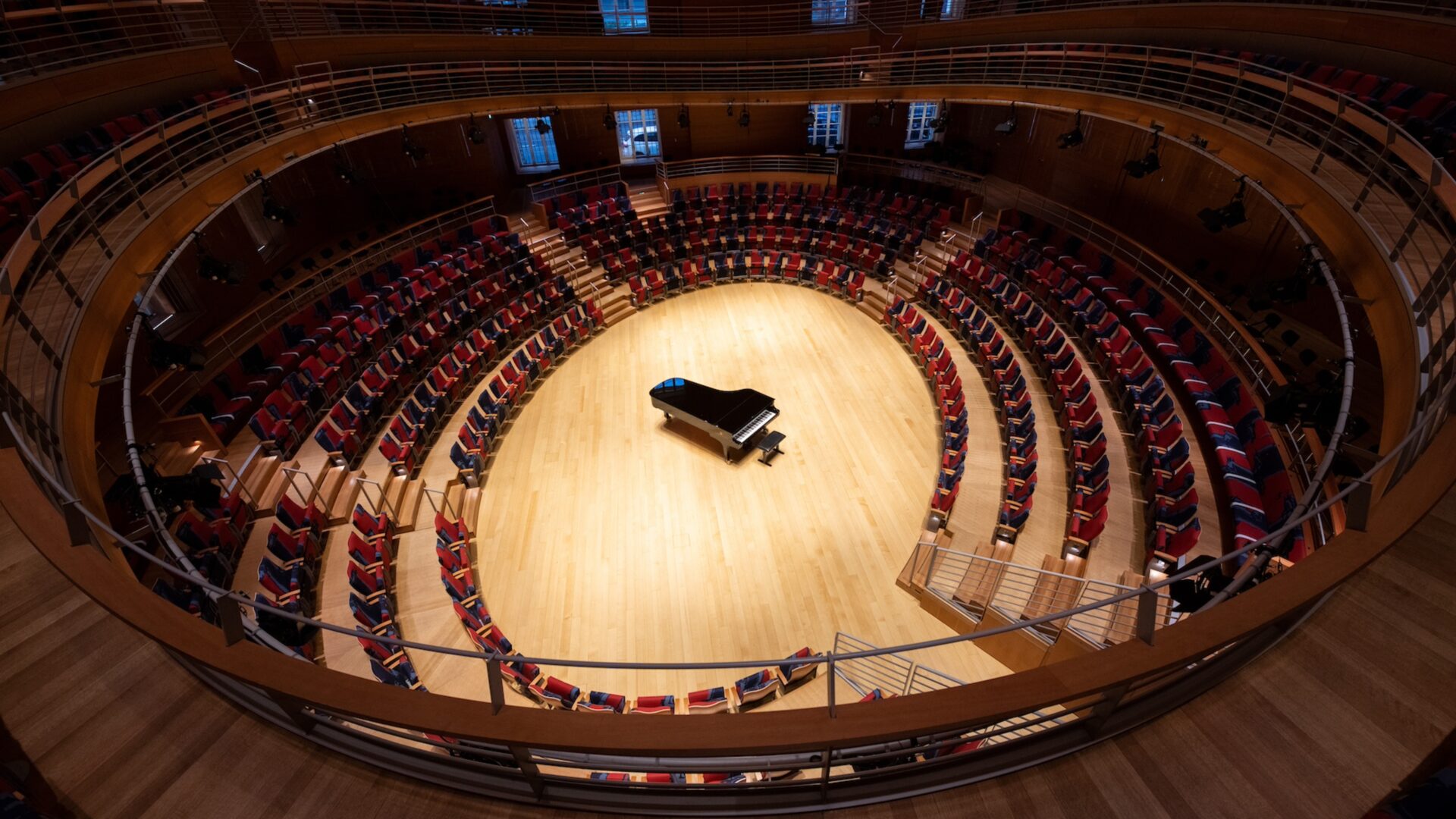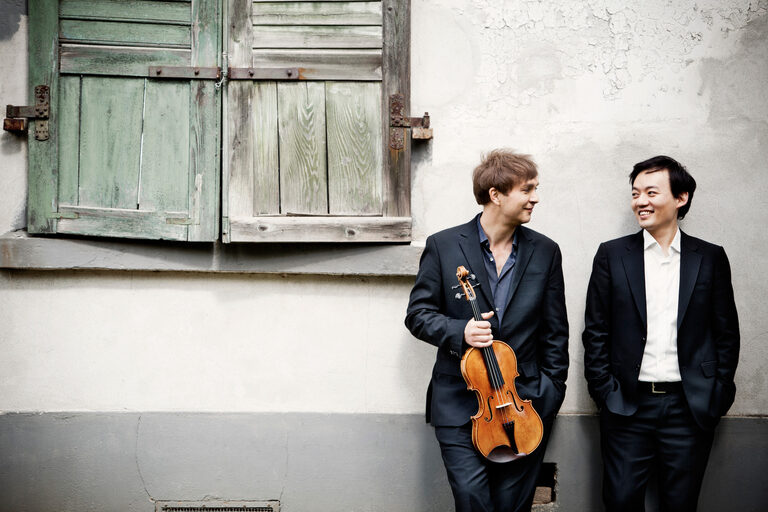Wed, January 31, 2024 at 7:30 PM
NILS MÖNKEMEYER & WILLIAM YOUN
Mosaic: Sonatas and Fragments by Mozart and Schubert
Pierre Boulez Saal
Even prolific geniuses such as Schubert and Mozart left behind numerous sketches and incomplete drafts that are rarely given attention alongside the celebrated masterpieces but sometimes contain the most daring experiments. In their duo recital, Nils Mönkemeyer and William Youn examine some of the fragments that have come down to us from these two composers in contemporary completions. In addition to these musical mosaics, they also perform Mozart’s Violin Sonata K. 379 and Schubert’s famous “Arpeggione” Sonata, both in arrangements for viola.
Artists
Viola
Piano
Program
EVENT TIMELINE
Imagining New Paths A Conversation with William Youn
You’ve been collaborating with Nils Mönkemeyer for quite some time. What’s at the core of your partnership?
We share a musical bond. We’ve been playing together for 14 years now, our first concert was in 2009. Over time, we’ve developed a deep understanding of each other, and I feel very comfortable performing with him. Also, there aren’t many pieces written for piano and viola, so we’ve been creative in crafting programs and discussing new ideas. Nils is a great partner in exploring new possibilities. This is also part of the program we’ll be performing at the Pierre Boulez Saal.
You’ve been collaborating with Nils Mönkemeyer for quite some time. What’s at the core of your partnership?
We share a musical bond. We’ve been playing together for 14 years now, our first concert was in 2009. Over time, we’ve developed a deep understanding of each other, and I feel very comfortable performing with him. Also, there aren’t many pieces written for piano and viola, so we’ve been creative in crafting programs and discussing new ideas. Nils is a great partner in exploring new possibilities. This is also part of the program we’ll be performing at the Pierre Boulez Saal.
You’ve chosen to pair two well-known works by Mozart and Schubert with several fragments and sketches. What drew you to this experiment?
I’ve been wondering how to describe this program in a few words. The other day, I went to see a William Turner exhibition, which included pieces he painted for public display but also some that were not meant for an audience—more private works like sketches and drafts in which he experimented. There was one in particular from his Venice sketchbook. We all know what Venice looks like, but this was just a silhouette with a bit of white and pink and yellow—you couldn’t really tell what it was unless you looked at the title. And then you realize: maybe it’s there, he may have used these colors to express certain emotions. I think sometimes music can also work like this—leading listeners to imagine.
How does this translate to your program?
For me, Mozart and Schubert are the most mysterious composers. Unlike Bach or Beethoven, who were very clear about their intentions, Mozart’s compositions often invite different interpretations. When I began working on pieces by Mozart and Schubert, I found myself questioning their musical meanings. In some of Mozart’s piano works, he seemed to be in such a hurry he didn’t provide specific instructions for the left hand, requiring me to interpret and fill in the accompaniment. Schubert, on the other hand, left his Sonata in F-sharp minor D 571 incomplete—it’s just a single movement. Similar questions about intention came up with the Mozart pieces we’ve selected for this program: are they unfinished or complete as they are? For the Sonata K. 379, for instance, which has two movements, there might have been a rondo at the end that Mozart didn’t write, or perhaps it was forgotten. The most famous work on the program is Schubert’s “Arpeggione” Sonata, composed for a forgotten instrument. I wondered why Schubert would have written such a piece and how it would have originally sounded. All of these questions emerged when we started developing this program.
This is not the first time you’ve worked with composer Isabel Mundry. How did this particular project come about?
A few years ago, when she was the artist in residence at Mozartfest in Würzburg, I performed her Piano Quintet. We share a profound love for Mozart, so when Nils and I were talking about his music and constant pursuit of new paths and ideas, we decided to ask Isabel if she would be interested in examining fragments of Mozart and compose something in response to them. It’s intriguing—what she has written sometimes serves as a bridge to Mozart and at other times forms a reaction or conclusion to his compositions. Some of the fragments are just a few bars, others are a bit longer, and you don’t always know where they stop. Considering what Isabel saw in these fragments becomes more like a conversation, inviting listeners to use their imagination.
You’ve also completed a fragment of a sonata movement by Schubert yourself. How did you go about this?
It was a very different kind of work compared to what Isabel has done. I don’t think anyone will notice my efforts—it was me as an interpreter, not a composer. This movement is a small piece in sonata form. To me it feels almost like an improvisation, an impromptu. It breaks off just before the recapitulation, and it seemed clear to me where it would lead, so I took the opportunity to finish it by adding a few bars. Rather than ending abruptly, it now feels like a whole piece.
Interview: Wioleta Zochowska
watch
YOUR VISIT
How To Get There
Pierre Boulez Saal
Barenboim-Said Akademie
Französische Straße 33d
10117 Berlin
_____
Public Transport
U-Bahn U2 Hausvogteiplatz, U5 Museumsinsel, U6 Unter den Linden
S-Bahn S / U Friedrichstraße
Tram M1, 12 Mitte / Am Kupfergraben
Bus 147 Werderscher Markt; 100, 300, N5 Staatsoper
Bicycle
Bicycle racks are available on the street “Hinter der Katholischen Kirche.”
Car
Q-PARK parking garage Unter den Linden / Staatsoper
Bebelplatz 2
10117 Berlin
Theater rate (5.30 pm – 11.30 pm, paid in advance): €10
Please note there is a construction site across from the hall on Französische Straße. The street is narrowed, and cars or taxis are not allowed to stop in front of the Pierre Boulez Saal entrance.
Opening Hours
Box Office
Monday to Friday 2 pm to 6 pm
Closed on weekends and holidays
On performance days, the box office opens one hour prior to an event on weekdays and two hours on Saturdays, Sundays, and holidays.
Papagena Call Center
Ticket hotline +49 30 4799 7411
Monday to Saturday 9am to 8pm
Sunday and public holidays 2pm to 8pm
Food & Drinks
Casalot Catering welcomes Pierre Boulez Saal visitors before and after concerts, serving a variety of dishes of Arab cuisine.
On concert nights, the bar opens one hour before the start of an event and remains open after the performance. You may also place pre-orders for intermission right at the counter.
More informantion on our catering can be found here.
Coat Check
Small bags up to a maximum size of A4 (21x30 cm) and jackets may be taken into the concert hall. Luggage, helmets, large umbrellas, and other bulky items must be stored at the coat check.
The coat check is free and located behind the staircase in the foyer, on the left-hand side.
Accessibility
To book wheelchair-accessible seating, other seats for visitors with disabilities, or companion seats, please contact us directly.
+49 30 4799 7411
tickets@boulezsaal.de
All wheelchair seats are accessible by elevator. All visitors, including patrons using a wheelchair, will enter the Pierre Boulez Saal through the main entrance. Tickets will be checked at the hall doors.
In order to make access as easy as possible, we kindly ask that you inform us of your requirements when booking your tickets.
Restrooms for visitors with disabilities are located in the basement and on the balcony level and are accessible by elevator.
Four parking spaces for visitors with disabilities are available on the street Hinter der Katholischen Kirche.


